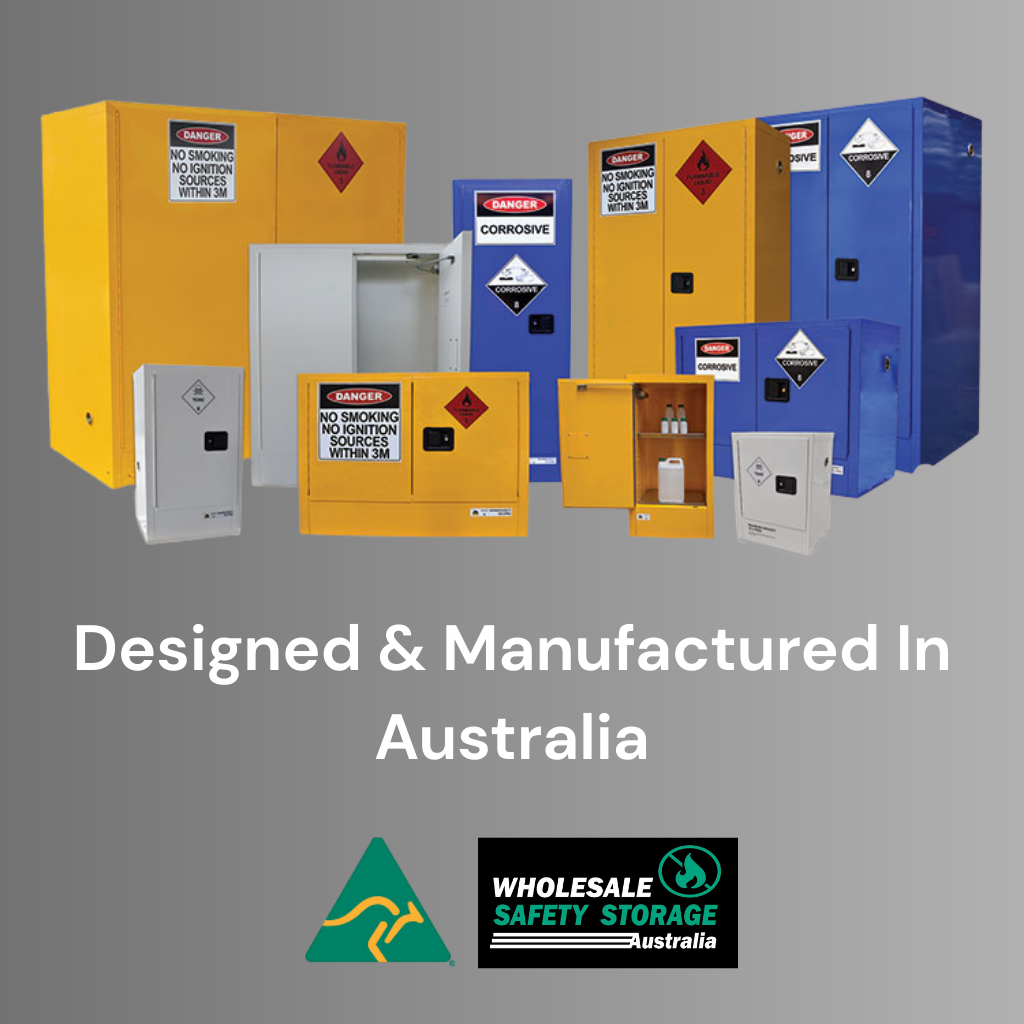Understanding Australian Standards for Dangerous Goods Storage: A Plain English Guide
When it comes to storing flammable, corrosive, toxic or gas cylinders in the workplace, it can feel like you need a lawyer and an engineer just to make sense of the standards. At WSSA, we believe in making safety storage simple. This guide breaks down the key Australian Standards that apply to dangerous goods storage – and explains how our cabinets, cages, and bunds are designed to meet them.
Why Australian Standards Matter
Every workplace that stores chemicals or fuels must comply with strict regulations. These rules aren’t just “red tape” – they exist to protect people, property, and the environment. Auditors, regulators and insurers all look to the relevant standards when assessing your site. Being compliant means fewer fines, smoother audits, and safer staff.
- AS 1940 – Flammable & Combustible Liquids
- AS 3780 – Corrosive Substances
- AS/NZS 4452 – Toxic Substances
- AS 4332 – Gas Cylinders
- ADG Code – Australian Dangerous Goods Code (transport & packaging)
Let’s break down how these apply in real workplaces.
Flammable Liquids – AS 1940:2017
Problem: Paints, solvents, fuels and adhesives give off vapours that can ignite with a single spark.
Standard requires: Storage in Class 3 cabinets or outdoor flammable stores with steel, double-walled construction, self-closing doors, spill containment sumps, and clear signage.
WSSA solution and Example: Our FLC250E indoor cabinet and FLC250-OD outdoor store are manufactured in Australia to meet AS 1940, with integrated bunding, flash arrestors and compliant venting.
Corrosive Substances – AS 3780:2008
Problem: Acids and alkalis can destroy skin, corrode metal containers, and damage floors or bunds if not managed properly.
Standard requires: Cabinets that resist chemical attack, self-closing doors, spill containment, and correct segregation from incompatible classes (like flammables or toxics).
WSSA solution and Example: Our CSC250 corrosives cabinet features chemical-resistant thermoplastic linings, integrated bunding, and tested compliance with AS 3780. It keeps your corrosives safe – and your site audit-ready.
Toxic Substances – AS/NZS 4452:1997
Problem: Pesticides, poisons and toxic chemicals can cause harm through fumes, spills, or even skin contact.
Standard requires: Double-walled cabinets with thermal barriers, flash arrestors, sump bunds, and warning signage.
WSSA solution and Example: Our TSC250 Toxic Substances Cabinet meets AS/NZS 4452 with 250L capacity, adjustable shelving and integral spill containment.
Gas Cylinders – AS 4332:2004
Problem: LPG, oxygen or acetylene cylinders under pressure can cause explosions or suffocation if not stored properly.
Standard requires: Ventilated, lockable cages with secure restraint chains, signage and compliance with AS 4332.
WSSA solution and Example: From small BBQ gas cages (BGBC2) through to forklift gas cages (FGBC4) and high-pressure cylinder cages (HPGCC4), our range is manufactured in Australia for outdoor, ventilated storage that passes audit checks every time.
Spill Containment Bunds – EPA & Safe Work Guidelines
Problem: IBCs and drums can leak thousands of litres if seals fail, contaminating soil, drains, and stormwater.
Standard requires: Bunding to hold at least 110% of the largest container (or a set percentage of total volume).
WSSA solution and Example: Choose from poly bunds for corrosives and oils, or steel bunds for flammable liquids. Our hard-top bunds (IBCCB-HTSS) even feature lockable covers to keep out rain and protect stored IBCs.
Segregation of Chemicals – WorkSafe & Safe Work Guidance
Even compliant cabinets and bunds can be unsafe if incompatible chemicals are stored together. Acids and chlorine, for example, can react to release toxic gases. That’s why segregation is critical.
WSSA solution and Example: We help businesses apply WorkSafe segregation charts and provide clear signage so that flammables, oxidisers, toxics and corrosives are kept apart in line with regulations.
Key Takeaways
- Use AS 1940 flammable cabinets for paints, solvents and fuels.
- Use AS 3780 corrosives cabinets for acids and alkalis.
- Use AS/NZS 4452 cabinets for pesticides and toxic chemicals.
- Store gas cylinders in AS 4332 compliant cages with ventilation.
- Always bund IBCs and drums to EPA sizing rules.
- Apply segregation charts to keep incompatible chemicals apart.
By following these rules and choosing equipment built to the right standards, you’ll make your site safer, compliant and audit-ready.
How WSSA Can Help
We stock a complete range of AS-compliant safety storage, including cabinets, cages, and bunds manufactured in Australia. Our team can help match the right solution to your site and provide supporting documentation for auditors and insurers. Contact us today to discuss your requirements.
